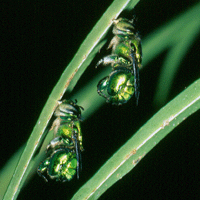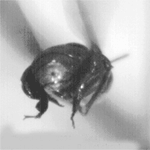Fragrance biology of orchid bees |
||||||
Neotropical orchid bees or euglossine bees (Apidae: Euglossini) are characterized by their very long tongues and by a unique behavior of males. Male orchid bees collect volatile chemicals (scents) from all sorts of fragrant objects, including flowers, tree wounds, decaying wood, and feces, and store them in hind leg pockets. That behavior is exploited by a great variety of neotropical orchids that attract euglossines as their exclusive pollinators. The males can also be baited with artificial scent compounds (cineole, methyl salycilate, vanillin etc.), and this technique has been used by a number of studies in population ecology. My work has centered on the mechanisms, dynamics and evolutionary causes of scent collection in male orchid bees. Together with Mark Whitten (Florida Museum of Natural History) and David Roubik (Smithsonian Tropical Research Institute) I found that individual males continuously forage for scents over much of their long lives and finally accumulate large quantities of complex chemical blends, 'perfumes' or 'fragrances' (Eltz et al. 1999). As volatiles are hard to come by we hypothesized that the the perfume serves as an indicator of male quality (viability, survival) that is judged by female bees prior to mating. Matings take place in small territories that are established by males around the stems of small trees in the forest, mostly on elevated ground on hills or ridges (Pokorny et al. 2017). Here, the males show a typical display behavior that involves frequent landings on the perch and short inspection flights to the near neighborhood. Female visits to these territories are very rare. If females prefer to mate with males that have rich and sexy perfumes, than the behavior of volatile collection could have evolved through sexual selection. We tried to test this hypothesis (female preference) with cage experiments in Panama but were unseuccessful due to low numbers of matings in the confined setting. However, we obtained the first video shots of orchid bee matings (Eltz, Roubik & Whitten, 2003). Using high-speed video and tracer experiments we have also demonstrated that the perfumes are exposed by males during display. We observed an intricate and highly repetitive leg movement during display of caged males of Euglossa cognata. Single-frame analysis demonstrated that the behavior involves several morphological structures of hitherto unknown function and suggests transfer of substances from the hind leg pocket to a tuft of hairs on the contralateral mid leg. Body-side-specific fluorescent dye application and consecutive detection of signals on males after display confirmed this transfer (Eltz, Sager & Lunau, 2005). Deposited on the mid tibial tufts, the fragrances are ideally placed in order to become ventilated by jugal combs on the wing bases, as suggested by Benjamin Bembé (2004). Being clearly distinct from motor patterns involved in volatile collection, the described movement is continuously performed by displaying males, suggesting an equally continuous exposure of volatiles. Chemically the fragrances are species-specific even when individuals from distant and ecologically divergent localities are considered (Eltz, Roubik & Lunau, 2005). Hexane extracts of male hind legs of two sympatric species of Eulaema exposed at their respective display sites on Barro Colorado Island quickly and exclusively attracted males of the "correct" species, which demonstrates that tibial fragrances can potentially mediate specific attraction (Zimmermann, Roubik & Eltz, 2006). However, it remained unclear whether conspecific males were the true signal adressees or whether they were simply eavesdropping on other males' mating "calls". More recently we extended our geographical scope to work with Euglossa viridissima in the Mexican state of Yucatán, where we collaborate with Javier Quezada-Euan (Departamento de Apicultura, Mérida). We have shown in cage experiments with isotopically labelled materials that males use an intricate conveyor belt mechanism for fragrance collection and concentration (Eltz et al. 2007). Further research is being done on male fragrance variation and the potential for fragrance driven sympatric speciation. We discovered that what has so far been called Euglossa viridissima are actually two reproductively isolated sibling species (Eltz et al. 2008), and described the new species as Euglossa dilemma Bembé & Eltz (Eltz et al. 2011). It happens that the populations of metallic green orchid bees that have recently become naturalized in Florida belong to the newly described species, E. dilemma. Further work has been and is being done on perfume evolution in a broad phylogenetic context in collaboration with Santiago Ramírez from UC Davis. Zimmermann et al. (2009) found that male perfume phenotypes of 15 species of Euglossa living sympatrically on Barro Colorado Island in Panama are clearly distinct, and that distinctness is surprisingly strong particularly in the most recently diverged lineages. This finding strengthens the view that perfumes are important for mate recognition, and that perfume phenotypes of sibling species underly diversifying selection in sympatry. The phylogenetic approach to perfume evolution was then widened to include a larger number of species and genera as well as samples from a broader geographic range (Weber et al. 2016, Eltz et al. 2024) In a renewed attempt to test if male perfumes evolved to lure females for mating, Santiago Ramírez and I set up more flight cages in southern Florida, where conditions for orchid bees are favorable and where one species, E. dilemma, can be trap-nested in good numbers. These experiments were finally successfull: In his PhD project Jonas Henske was able to show that males injected with natural perfume (harvested from wild males of E. dilemma) were significanlty more successfull in acquiring matings compared to "empty" males (Henske et al. 2023)" References: Eltz, T., Whitten, W. M., Roubik, D. W. & Linsenmair, K. E. 1999. Fragrance collection, storage, and accumulation by individual male orchid bees. Journal of Chemical Ecology, 25, 157-176. Eltz, T., Roubik, D. W. & Whitten, W. M. 2003. Fragrances, male display and mating behaviour of Euglossa hemichlora - a flight cage experiment. Physiological Entomology, 28, 251-260. Pokorny. P., Vogler, I., Losch, R., Schlütting, P., Juarez, P., Bissantz, N., Ramirez, S.R. & Eltz, T. (2017) Blown by the wind: the ecology of male courtship display behavior in orchid bees. Ecology 98: 1140-1152 Bembé, B. 2004. Functional morphology in male euglossine bees and their ability to spray fragrances (Hymenoptera, Apidae, Euglossini). Apidologie, 35, 283-291. Eltz, T., Sager, A. & Lunau, K., 2005. Juggling with volatiles: exposure of perfumes by displaying male orchid bees. Journal of Comparative Physiology A, 191, 575-581. Eltz T., Roubik D.W. & Lunau K., 2005. Experience-dependent choices ensure species-specific fragrance accumulation in male orchid bees. Behavioral Ecology and Sociobiology, 59, 149-156. Zimmermann Y., Roubik D.W. & Eltz T., 2006. Species-specific attraction to pheromonal analogues in orchid bees. Behavioral Ecology and Sociobiology, 60, 833-843. Eltz, T., Zimmermann, Y., Haftmann, J., Twele, R., Francke, W., Quezada-Euan, J. J. G. & Lunau, K., 2007. Enfleurage, lipid recycling, and the origin of perfume collection in orchid bees. Proceedings of the Royal Society B-Biological Sciences 274: 2843-2848. Eltz T., Zimmermann Y., Pfeiffer C., Ramírez Pech J., Twele R., Francke W., Quezada-Euan J.J.G. , Lunau, K. (2008) An olfactory shift is associated with male perfume differentiation and species divergence in orchid bees. Current Biology 18, 1844-1848. Zimmermann Y., Ramírez S. R. & Eltz T. (2009) Chemical niche differentiation among sympatric species of orchid bees. Ecology 90: 2994-3008. PDF Ramírez S. R., Eltz T., Fritzsch F., Pemberton R. W., Pringle E. G. & Tsutsui N.D. (2010) Intraspecific geographic variation of fragrances acquired by orchid bees in native and introduced populations. Journal of Chemical Ecology 36: 873-884. PDF Eltz T., Fritzsch F., Ramírez Pech J., Zimmermann Y., Ramírez S. R., Quezada-Euan J. J. G. & Bembé B. (2011) Characterization of the orchid bee Euglossa viridissima (Apidae: Euglossini) and a new cryptic sibling species by morphological, chemical, and genetic characters. Zoological Journal of the Linnean Society 163: 1064–1076. PDF Weber, M.G., Mitko L., Eltz T. & Ramírez, S.R. (2016) Macroevolution of perfume signalling in orchid bees. Ecol Lett 19: 1314-1323. Eltz, T., Mende, T. & Ramírez, S.R. (2024) Evolution of acquired perfumes and endogenous lipid secretions in Orchid Bees. J Chem Ecol 50: 430-438. Henske, J., Saleh, N.W., Chouvenc, T., Ramírez, S.R. & Eltz, T. (2023) Function of environment-derived male perfumes in orchid bees. Curr Biol 33: 2075-2080. |
|
RUB » Dekanat für Biologie und Biotechnologie » Evolutionsökologie und Biodiversität der Tiere - Mitarbeiterhomepage PD Dr. Th. Eltz





